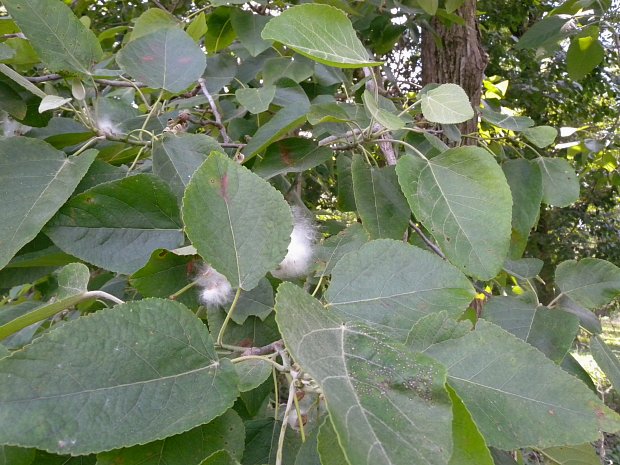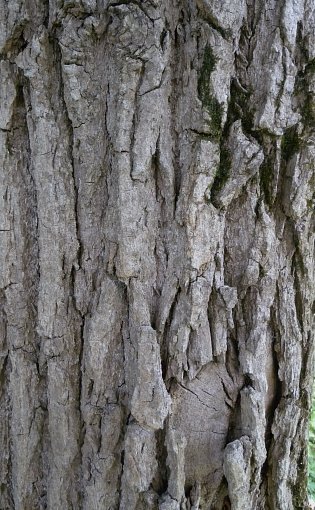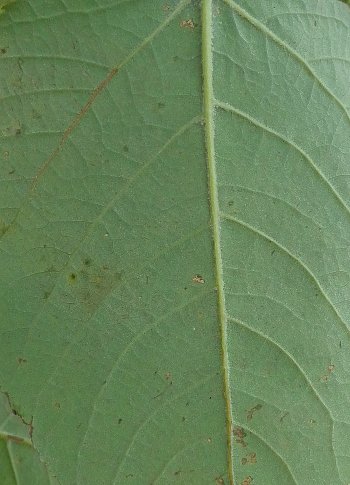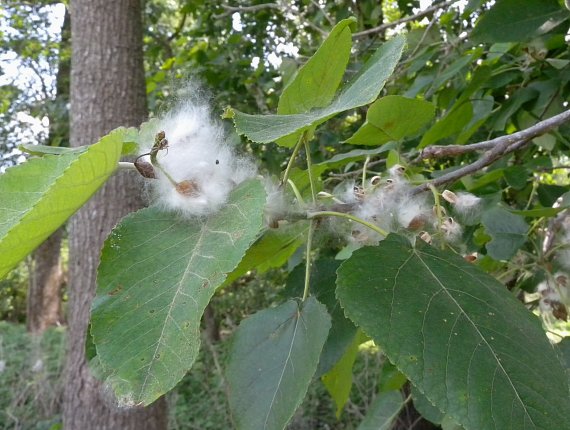
Swamp Cottonwood is dioecious, forming staminate (male) and pistillate (female) catkins on separate trees. Staminate catkins are narrowly cylindrical, yellowish, pendulous, and 2-4" long, consisting of numerous staminate florets along a central axis. Each staminate floret (about 1/8" or 3 mm. long) consists of 12-20 stamens and a calyx-like disk that is shaped like a shallow saucer. Adjacent to each of these florets, there is a fringed brown bract that is typically glabrous on one side and pubescent on the other. Pistillate catkins are narrowly cylindrical, greenish, widely spreading to ascending, and 2-3" long (becoming 3-6" long with the maturity of the seed capsules). Each pistillate floret (about 1/8" or 3 mm. long) consists of an ovary with 2-4 stigmata and a calyx-like disk that is toothed. Each stigma has a flattened fan-like surface with an undulate outer margin. Adjacent to each of these florets, there is a fringed brown bract that is typically glabrous on one side and pubescent on the other. Both staminate and pistillate florets have pedicels about ¼" long (becoming ½" long with the maturity of the seed capsules). The blooming period occurs during mid-spring for about 1-2 weeks. The florets are cross-pollinated by the wind. Afterwards, the pistillate florets are replaced by seed capsules that turn brown at maturity, splitting open into 2-3 parts to release their seeds during the late spring or early summer. These capsules are up to ½" long, glabrous, and ovoid in shape. The minute seeds are embedded in tufts of cottony hairs; they are distributed by either wind or water. The woody root system is shallow and spreading.

Cultivation: The preference is full or partial sun, wet conditions, and an acidic soil containing clay (less often sand or silt). This tree grows moderately fast, but it is relatively short-lived (maximum age of about 100 years). Viability of the seeds persists for only 1-2 weeks; they require sunlight and moisture for germination. Individual trees can produce seeds in as little as 10 years of age. Seasonal flooding of the ground is readily tolerated.
Range & Habitat: The native Swamp Cottonwood is uncommon in southern Illinois and absent from the rest of the state (see Distribution Map). Illinois lies along the NW range-limit of this species. Habitats include floodplain woodlands, swamps, and low areas around lakes. Common canopy associates include Taxodium distichum (Bald Cypress), Nyssa aquatica (Water Tupelo), and Salix nigra (Black Willow). Swamp Cottonwood is a pioneer species that thrives in open disturbed areas with abundant moisture. As compared to one of its main competitors, Populus deltoides (Eastern Cottonwood), it is able to tolerate locations that are more waterlogged.

Faunal Associations: Swamp Cottonwood is a host tree to many of the same insects that feed on other poplar trees (Populus spp.). These species include larvae of metallic wood-boring beetles, larvae of long-horned beetes, leaf beetles, weevils, larvae of leaf-miner flies, plant bugs, aphids, armored scales, mealybugs, larvae of sawflies, larvae of Geometer moths, larvae of leaf blotch miner moths (Gracillariidae), larvae of owlet moths (Noctuidae), larvae of prominent moths (Notodontidae), larvae of clear-winged moths (Sesiidae), larvae of Sphinx moths, larvae of Tortrix moths, and larvae of brush-footed butterflies (Limenitis spp., Nymphalis spp.). Some birds may feed on the buds and catkins of this tree, and it may be selected as a nesting site for some birds, particularly woodpeckers. Mammals that use this tree and other poplar trees as a food source include beavers (wood, bark), deer (foliage, twigs), and voles (bark of saplings). Beavers use branches of these trees in the construction of their dams and lodges.
Photographic Location: A low area near a lake in southern Illinois.

Comments: Most people are unfamiliar with Swamp Cottonwood because it is uncommon and rarely cultivated. It is distributed primarily along the lower Mississippi River basin and southeastern Atlantic coastal areas, although there are local distributions of this tree along the lower Great Lakes in northern Indiana and northern Ohio. Swamp Cottonwood can be distinguished from other Populus spp. by the shape of its relatively large leaves (oval-cordate) and their blunt tips. Its leaves resemble those of Populus balsamifera (Balsam Poplar), but this latter tree has a more northern distribution and the terminal buds of its winter branches are very resinous. Among native and naturalized Populus spp. in Illinois, Swamp Cottonwood has a unique technical characteristic: Its pistillate (female) florets have discs with distinctly toothed margins, instead of smooth (entire) or undulate margins. Similar to Populus deltoides (Eastern Cottonwood), the wood of Swamp Cottonwood is light-weight and relatively weak; it has been used to make cardboard boxes, wooden crates, interior parts of furniture, and high-quality pulp paper. Other common names of Populus heterophylla include Black Cottonwood, River Cottonwood, Downy Poplar, and Swamp Poplar.